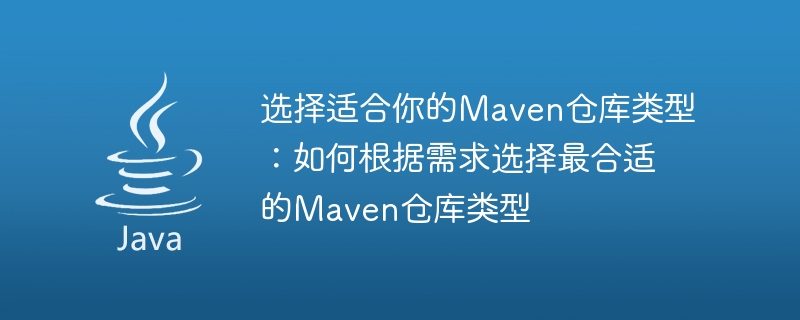

As the complexity of software development and the size of the team increase, the use of dependency management tools has become a necessity. In the field of Java development, Maven has become one of the most popular dependency management tools. As a tool based on building projects, Maven uses a unified build description file (pom.xml) to manage project dependencies.
An important concept of Maven is the repository, which is the place where Maven artifacts are stored and published. When using Maven, we need to choose a warehouse type that suits us so that we can better manage and use the project's dependencies.
In Maven, warehouses are mainly divided into two types: local warehouse (Local Repository) and remote warehouse (Remote Repository).
First, let’s introduce the local warehouse. The local warehouse is a directory of Maven on the local machine, used to store local components. When we use Maven for the first time, a hidden folder named ".m2" will be created in the user directory by default as the default location of the local warehouse. Whenever we execute a Maven build command, Maven will automatically find and download the required dependency components from the local warehouse. Of course, if the required components are not available in the local repository, Maven will automatically search and download them from the remote repository.
For a small project developed by a single person, just use the default local warehouse. In this case, we only need to keep the local repository clean and orderly, and do not need to consider sharing with other developers.
However, for a large project or a large-scale development team, using the default local repository may cause some problems. First of all, it is very difficult for multiple developers to use the same version number to manage dependencies, because each developer has his own independent local warehouse. Secondly, each developer needs to manually manage dependent libraries in the local warehouse, which may cause version conflicts and component inconsistencies.
In order to solve these problems, we can use remote warehouses. A remote repository is a central repository for storing and publishing shareable artifacts. Maven's Central Repository is a public remote warehouse that contains a large number of commonly used open source components. We can publish the project components to the remote warehouse by configuring the URL address of the remote warehouse, and other developers can obtain these components through the same URL address.
In addition to the central warehouse, we can also use third-party remote warehouses. For example, if we want to use the latest version of the Spring framework, we can configure Spring's remote warehouse address and let Maven obtain the required dependency components from this warehouse.
The advantage of using a remote warehouse is that it can effectively solve the problem of version consistency when multiple people collaborate on development. You only need to configure the address of the remote warehouse into the project's pom.xml file, and all developers can obtain the required components directly from the remote warehouse without manual downloading and management. In addition, for some private components, we can also build our own remote warehouse for better management and control.
To sum up, it is very important to choose the type of warehouse that suits you. For small projects and individual developers, using the default local repository can meet their needs. For large projects and multi-person collaborative development, remote warehouses can be used to better manage and share components. Whether it is a central warehouse or a self-built private warehouse, you can choose according to your specific needs. When configuring the warehouse, we need to pay attention to choosing a stable and reliable warehouse to ensure that the required components can be obtained in time.
Therefore, it is very important to choose the most appropriate Maven warehouse type based on the size of the project and the size of the team. Local repositories are suitable for small-scale personal projects, while remote repositories are suitable for large-scale team projects. Whether it is a central warehouse or a private warehouse, choosing a stable and reliable warehouse is a key factor in ensuring the smooth progress of the project. When configuring the warehouse, we also need to pay attention to version consistency and component management issues to avoid unnecessary conflicts and errors. Choosing the Maven warehouse type that suits you will help improve the maintainability and development efficiency of the project.
The above is the detailed content of How to choose the most suitable Maven repository type for your needs: A guide to choosing the Maven repository type that's right for you. For more information, please follow other related articles on the PHP Chinese website!




